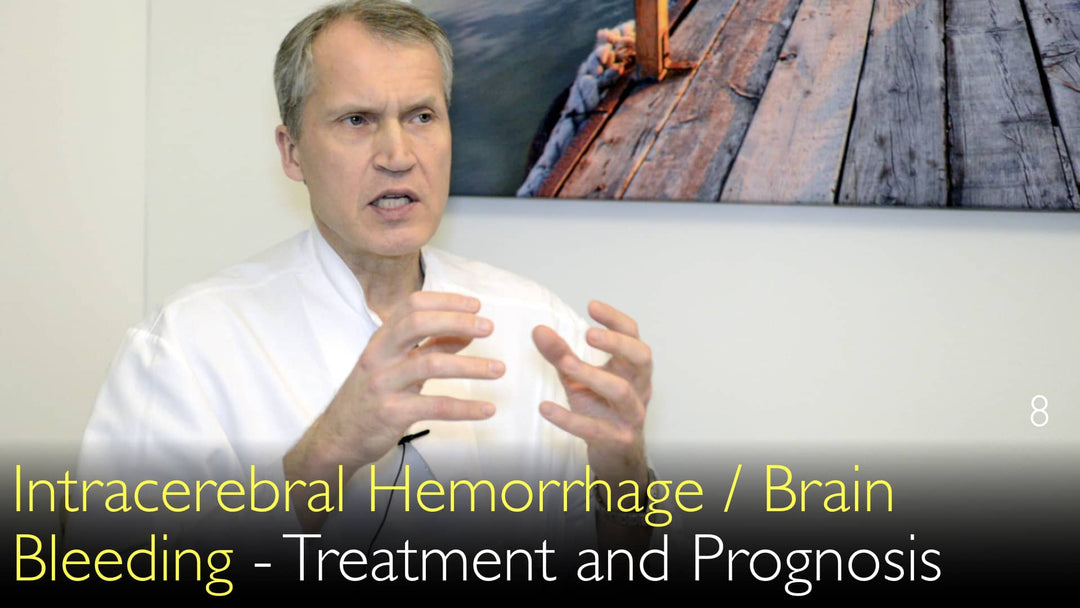Leading expert in intracerebral hemorrhage, Dr. Mika Niemela, MD, explains the critical role of prevention in brain bleeding outcomes. He emphasizes that hypertension treatment is the most effective strategy. Surgical intervention for hypertensive bleeds often provides limited benefit. Dr. Mika Niemela, MD, highlights geographical differences in stroke types, noting a higher incidence of hemorrhagic strokes in Asia. The prognosis for intracerebral hemorrhage has seen little improvement over decades.
Intracerebral Hemorrhage Treatment and Prognosis: A Focus on Prevention
Jump To Section
- Prevention as the Key Approach
- Surgical Intervention Limitations
- Prognosis Research Insights
- Geographical Variations in Stroke
- Treatable Vascular Lesions
- Full Transcript
Prevention as the Key Approach
Dr. Mika Niemela, MD, asserts that prevention is the best method to treat brain bleeding. He identifies hypertension treatment as the single most critical factor. This approach focuses on addressing the root cause rather than managing the consequences. Effective blood pressure control can significantly reduce the risk of a primary intracerebral hemorrhage event.
Surgical Intervention Limitations
Dr. Mika Niemela, MD, discusses the limited role of surgery for most intracerebral hemorrhages. He explains that surgery has not been proven very beneficial for hypertensive bleeds, especially those located in the basal ganglia. An exception exists for posterior fossa hematomas that cause hydrocephalus. In these specific cases, surgical intervention may be advocated to relieve pressure on the brain.
Prognosis Research Insights
Dr. Mika Niemela, MD, shares insights from three decades of research in Helsinki. His work has focused on early and late prognostic factors for brain bleeding outcomes. Unfortunately, the overall prognosis for intracerebral hemorrhage has not changed significantly over this period. This stagnation highlights the challenging nature of this condition and the urgent need for better treatment strategies.
Geographical Variations in Stroke
Dr. Anton Titov, MD, and Dr. Mika Niemela, MD, explore interesting epidemiological patterns. In Asian populations, hypertensive brain bleeds are more common than ischemic strokes. Western European populations show the opposite trend, with ischemic stroke being more prevalent. This disparity may be linked to dietary factors and differences in hypertension management practices across regions.
Treatable Vascular Lesions
Dr. Mika Niemela, MD, clarifies when surgical intervention becomes appropriate. He notes that surgery is reserved for specific structural causes of bleeding. These include brain cavernomas, cerebral aneurysms, and arteriovenous malformations. For these vascular lesions, direct treatment of the abnormality can prevent future bleeding events and improve patient outcomes significantly.
Full Transcript
Dr. Anton Titov, MD: Prevention is the best way to treat brain bleeding. Treatment of hypertension is the key. Leading brain surgeon on intracranial bleeding treatment options and prognosis. Intracerebral hemorrhage is one of your particular interest areas in clinical work. You also do research on bleeding inside the brain.
Dr. Mika Niemela, MD: Yes. I have done research on early and late prognostic factors for the outcomes of patients with intracerebral hemorrhage.
Dr. Anton Titov, MD: What have you learned from your research about bleeding into the brain?
Dr. Mika Niemela, MD: Brain bleeding was studied here in Helsinki for almost 30 years. There were several case series of patients with intracerebral hemorrhage. Unfortunately, the brain bleeding prognosis has not changed much. It does not matter whether we treat cerebral hemorrhage or not.
Surgery has not been proven to be very beneficial. Surgery does not help much when hypertensive brain bleeding happens in the basal ganglia area. The brain bleeding could be in the posterior fossa of the skull. It could cause hydrocephalus.
Then treatment may be advocated mainly due to the hydrocephalus. But if there is no hydrocephalus in the posterior fossa brain hematoma, it's better not to operate on brain hemorrhage directly.
Dr. Anton Titov, MD: Prevention is the best method to treat brain bleeding. Treatment of hypertension is the key. Hypertension, especially in Asia, may be a problem. There are more hypertensive brain bleeds than ischemic strokes.
In the Western countries there is more ischemic strokes than brain hemorrhages. Maybe it is due to a different diet.
Dr. Mika Niemela, MD: In Western European population ischemic stroke is maybe a more problem than a brain bleeding. There is more hypertension in patients as you go to the East. Hypertension may be treated or untreated.
Dr. Anton Titov, MD: Patients may have untreated hypertension. Then have more brain bleeds.
Dr. Mika Niemela, MD: That is why prevention is the key to prognosis in intracerebral brain bleeding. It is not surgery. We only treat brain cavernoma, or brain aneurysm, or arteriovenous malformation. They could be a cause of bleeding into the brain.







